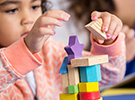Counting Dice Roll
In this lesson, children will count by ones using counters to match the roll of a die.
Lesson for:
Toddlers/Preschoolers
(See Step 5: Adapt lesson for toddlers or preschoolers.)
Content Area:
Numbers and Operations
Learning Goals:
This lesson will help toddlers and preschoolers meet the following educational standards:
- Understand numbers, ways of representing numbers, relationships among numbers and number systems
Learning Targets:
After this lesson, toddlers and preschoolers should be more proficient at:
- Counting
- Matching die roll to counters

Counting Dice Roll
Lesson plan for toddlers/preschoolers
Step 1: Gather materials.
- Dice
- Counters such as pennies, beans, buttons, marbles, or paperclips
- Containers to hold the counters for each group of 3 children
- Book: Richard Scarry’s Best Counting Book Ever by Richard Scarry
Note: Small parts pose a choking hazard and are not appropriate for children age five or under. Be sure to choose lesson materials that meet safety requirements.
Step 2: Introduce activity.
- Read Richard Scarry’s Best Counting Book Ever by Richard Scarry.
- Choose children to come up and identify an item to count on each page of the book. As each child counts, observe each child’s ability to use one-to-one correspondence while counting items on the page. Make notes for yourself as needed about which children may need further assistance or instruction on counting using one-to-one correspondence.
- Show children a die and explore each side with them.
- Choose one child to come up and roll the die and then count the dots from the roll to identify the number.
- Choose a second child to come up and count out the counters to match the roll on the die.
- Repeat steps four and five until every child has had a turn rolling a die or counting counters.
Step 3: Engage children in lesson activities.
- Say: “Now we are going to play a counting game in small groups, using a die and a bowl of counters.”
- Place children in groups of three. (Note: You will need to make decisions about how to group children. You may want to group those that can reliably count using one-to-one correspondence together OR you may want to group those needing assistance with those who are confident and can assist others.)
- Give each group a container with counters and one die. For more advanced children you may want to give them two dice.
- Identify the child in each group that will roll the die first. Each child takes a turn rolling the die and then counting out the matching number of counters for his/her own pile.
- Continue the game until all counters are used.
- Ask the children to count their total number of counters at the end of the game.
- Ask questions:
- “Who has the most counters?”
- “Who has the least counters?”
- “Does anyone have the same number of counters?”
Step 4: Vocabulary.
- Most: Having the greatest quantity or number (e.g., “Who has the most counters?”)
- Least: Having the smallest quantity or number (e.g., “Who has the least counters?”)
- Same: Identical in kind or quantity (e.g., “Who has the same amount of counters?”)
Step 5: Adapt lesson for toddlers or preschoolers.
Adapt Lesson for Toddlers
Toddlers may:
- Place small pieces in their mouths
- Take all of the counters at once
- Not be able to count numbers up to six
- Not have one-to-one correspondence
Child care providers may:
- Use large counters
- Give the counters to children one at a time
- Provide assistance when children need to count all counters at the end of the game
- Provide assistance when children are counting to emphasize counting one by one with the counters
Adapt Lesson for Preschoolers
Preschoolers may:
- Want to work alone
- Be able to count higher than six
- Not be able to count the total number of counters at the end of game if the number is high
Child care providers may:
- Give each child a die and instruct the children to take turns rolling the die, taking the appropriate number of counters and counting their piles once the counters are all gone
- Allow children to use more than one die
- Provide assistance when children need to count all of the counters at the end of the game
Suggested Books
- Best Counting Book Ever by Richard Scarry (New York: Sterling, 2010)
- Fish Eyes: A Book You Can Count On by Lois Ehlert (New York, Harcourt Brace, 1990)
- Little 1 by Ann Rand and Paul Rand (Vancouver, BC: Raincoast Books, 1962)
- Dog’s Colorful Day by Emma Dodd (New York: Penguin Group, 2000)
Music and Movement
Outdoor Connections
- Roll the die and ask the children to do a movement like jumping or hopping for the number of times rolled (if a five is rolled, the children should jump 5 times).
- Look for objects outside such as rocks, leaves or sticks; put them in a pile, roll the die and take the amount rolled from the pile.
- Stand on one side of the yard with the children on the other. Roll the die and tell the children to take steps toward you in the amount that was rolled (if you roll a five, the children take five steps toward you). The children should stop once they reach you.
- Stand on one side of the yard with the children on the other. Roll the die and ask one child to take steps toward you in the amount that was rolled. Then the next child has a turn. Do this until one child reaches you and wins.
Comment on this lesson